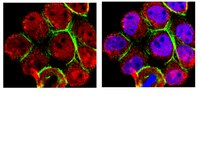Clld7, a candidate tumor suppressor on chromosome 13q14, regulates pathways of DNA damage/repair and apoptosis.
Zhou, X; Münger, K
Cancer research
70
9434-43
2010
Mostrar Resumo
Chronic lymphocytic leukemia deletion gene 7 (Clld7) is a candidate tumor suppressor on chromosome 13q14. Clld7 encodes an evolutionarily conserved protein that contains an RCC1 domain plus broad complex, tramtrack, bric-a-brac (BTB), and POZ domains. In this study, we investigated the biological functions of Clld7 protein in inducible osteosarcoma cell lines. Clld7 induction inhibited cell growth, decreased cell viability, and increased γ-H2AX staining under conditions of caspase inhibition, indicating activation of the DNA damage/repair pathway. Real-time PCR analysis in tumor cells and normal human epithelial cells revealed Clld7 target genes that regulate DNA repair responses. Furthermore, depletion of Clld7 in normal human epithelial cells conferred resistance to apoptosis triggered by DNA damage. Taken together, the biological actions of Clld7 are consistent with those of a tumor suppressor. | Western Blotting | 20926398
 |
Linear antigenic sites defined by the B-cell response to human p53 are localized predominantly in the amino and carboxy-termini of the protein.
Legros, Y, et al.
Oncogene, 9: 2071-6 (1994)
1994
Mostrar Resumo
Using a set of overlapping peptides of the human p53 protein, we analysed the epitopes recognized by 18 monoclonal antibodies specific for human p53. We showed that most of these epitopes correspond to linear antigenic determinants which lie predominantly in the amino- or carboxy-terminus of the p53 protein. Using either truncated p53 or the set of human p53 peptides, we directly analysed the sera of animals immunized with human p53. These sera contained antibodies which also recognized the regions corresponding to the extremity of the p53 protein. These p53 regions were similar to those recognized by p53-specific antibodies present in sera of patients with cancer. Preferential recognition of these regions by antibodies specific for non conformational epitopes suggested that these regions are localized at the surface of the p53 protein as unfolded structures. | | 8208553
 |
Increased expression of mutant forms of p53 oncogene in primary lung cancer.
Iggo, R, et al.
Lancet, 335: 675-9 (1990)
1990
Mostrar Resumo
Primary lung cancer samples of the major histological types were examined for expression of the tumor suppressor gene p53 by immunohistochemistry. Abnormalities in p53 expression were found in 28 of 40 carcinomas, 14 of 17 squamous tumours showing abnormal p53 expression, whereas no expression of p53 was detectable in 7 carcinoid tumours or in 10 normal lung samples. Direct evidence for homozygous expression of mutant p53 mRNA in representative carcinomas was obtained by means of an asymmetric polymerase chain reaction mRNA sequencing strategy, which allowed sequencing without any cloning step. All the mutations were G to T transversions resulting in mis-sense mutations in aminoacids highly conserved in evolution. Mutation of the p53 gene is the most frequently identified genetic change in human lung cancer; these findings suggest that simple immunohistological methods can provide strong evidence of such mutation. | | 1969059
 |
Activating mutations in p53 produce a common conformational effect. A monoclonal antibody specific for the mutant form.
Gannon, J V, et al.
EMBO J., 9: 1595-602 (1990)
1990
Mostrar Resumo
Point mutations in the p53 gene are the most frequently identified genetic change in human cancer. They convert murine p53 from a tumour suppressor gene into a dominant transforming oncogene able to immortalize primary cells and bring about full transformation in combination with an activated ras gene. In both the human and murine systems the mutations lie in regions of p53 conserved from man to Xenopus. We have developed a monoclonal antibody to p53 designated PAb240 which does not immunoprecipitate wild type p53. A series of different p53 mutants all react more strongly with PAb240 than with PAb246. The PAb240 reactive form of p53 cannot bind to SV40 large T antigen but does bind to HSP70. In contrast, the PAb246 form binds to T antigen but not to HSP70. PAb240 recognizes all forms of p53 when they are denatured. It reacts with all mammalian p53 and chicken p53 in immunoblots. We propose that immunoprecipitation of p53 by PAb240 is diagnostic of mutation in both murine and human systems and suggest that the different point mutations which convert p53 from a recessive to a dominant oncogene exert a common conformational effect on the protein. This conformational change abolishes T antigen binding and promotes self-oligomerization. These results are consistent with a dominant negative model where mutant p53 protein binds to and neutralizes the activity of p53 in the wild type conformation. | | 1691710
 |













